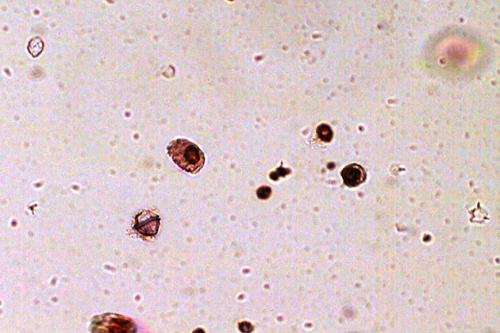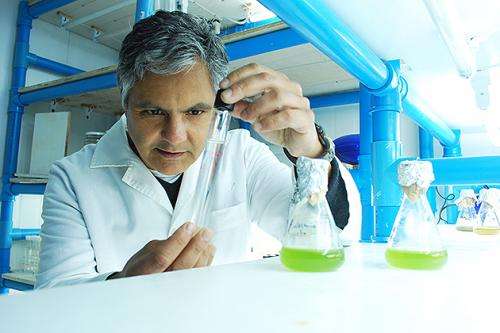Algal bloom species with two deadly toxins could disrupt marine food web

(Phys.org) -- When tiny aquatic organisms reproduce in large amounts, algal blooms occur that take over portions of open water up to hundreds of miles in area.
And when these oceanic plankton happen to be the toxic kind, they can be deadly to other living things crossing their path.
One of the most poisonous and abundant of these plankton, the species Alexandrium tamarense, produces paralytic shellfish toxin (PST), a neurotoxin that can result in death when ingested in large amounts by mammals, including humans.
Now, Professor Hans Dam and his research group in the Department of Marine Sciences have shown that this microscopic alga also produces a second kind of deadly toxin, one that attacks some of the algae’s tiny predators and, along with PST, could ultimately upset entire marine food chains. Dam published his findings in the May 2012 issue of the journal Aquatic Microbial Ecology.
“The amazing thing is, when you look at these algae under a microscope, they’re so beautiful – but they’re so deadly,” says Dam. “We call them the beautiful assassins.”
Like plants, these one-celled organisms make their own food from the light of the sun. The Alexandrium species lives in cold seawater in the northern and southern hemispheres, and is found from the Long Island Sound up to the northernmost Canadian borders. In 2005, a major bloom – sometimes referred to as a red tide – occurred throughout the northeast coast, severely affecting the Cape Cod area.

In small numbers, Alexandrium is virtually harmless to humans, says Dam. But when they’re eaten by clams, mussels, or other microorganisms – which are then eaten by small crustaceans, which are in turn eaten by larger crustaceans or fish – the toxins can build up in large amounts. So in some parts of the world, eating contaminated lobsters, clams, and fish has led to illness or death.
However, says Dam, PST only affects animals that have central nervous systems.
“This toxin blocks sodium channels in anything that has a well-developed nervous system,” he says. “But most of the organisms in the ocean are not those kinds of organisms. They’re single-celled, similar to the algae themselves, and they don’t have a well-developed nervous system.”
Scientists had begun to notice that even though Alexandrium’s toxin isn’t supposed to affect single-celled animals, when the alga was in the vicinity of some of its one-celled predators, some of those predators got sick and died. Dam’s post-doctoral researcher Hayley Flores showed in laboratory experiments that in fact the alga produces a different toxin, called a reactive oxygen species, that kills its predators by popping their cell membrane.
“If you only have one cell, losing your cell membrane is all it takes to kill you,” says Dam. “This new mechanism of toxicity, combined with the other, is pretty evil.”
Dam speculates that this ability to harm both large and small oceanic predators could lead to disruptions in the marine food web during large Alexandrium blooms.
“These small predators that are being affected by the reactive oxygen species are the things that typically eat large amounts of the algae and keep them from growing like crazy,” says Dam. “This brings up a whole new line of inquiry for us: What will actually control these algae in the future?”
Dam notes that although harmful algal blooms have been linked to human activities, such as pollution runoff from rivers, there are many different factors that could affect the blooms, and scientists still aren’t sure exactly how they begin. He speculates that the algae may have become more toxic over time, which has led to their proliferation.
His group will next try to understand how the alga produces the reactive oxygen species and whether it also affects multicellular animals. He’s also working with researchers at the University of Los Lagos in Chile to understand how Alexandrium may affect important commercial species such as salmon and king crab. And his group recently received funding from Connecticut Sea Grant to study the effects of temperature on plankton in the Long Island Sound.
Dam says that even though humans have little to fear, the marine world could see shifts based on just this one group of species.
“If it’s killing multicellular animals with one toxin and small protists with another,” he says, “it could be the killer of the ocean world.”
More information: Full study: www.int-res.com/abstracts/ame/v66/n2/p199-209/
Provided by University of Connecticut

















